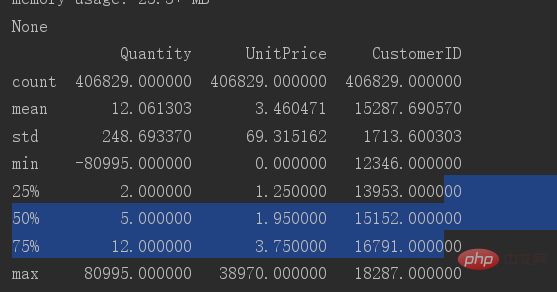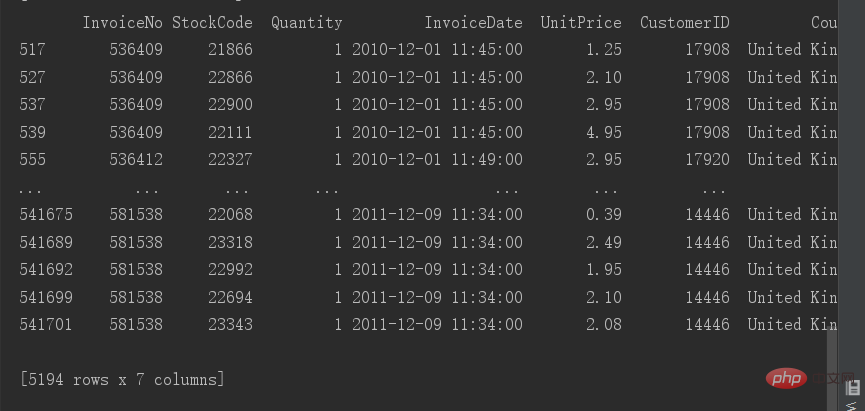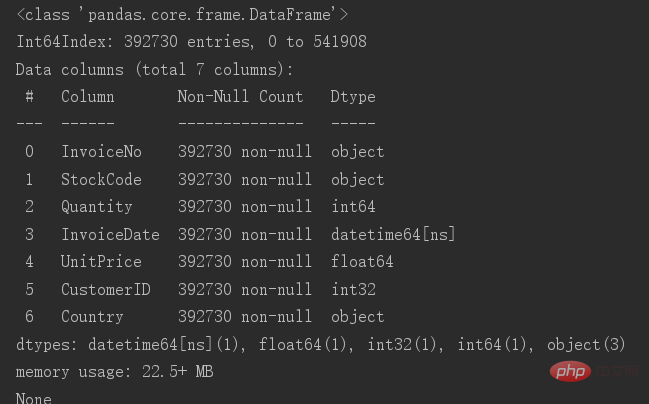What is the data cleaning method in Python?
The library needed for data cleaning here is the pandas library. The download method is still running in the terminal: pip install pandas.
First we need to read the data
import pandas as pd data = pd.read_csv(r'E:\PYthon\用户价值分析 RFM模型\data.csv') pd.set_option('display.max_columns', 888) # 大于总列数 pd.set_option('display.width', 1000) print(data.head()) print(data.info())
Line 3 It is to read the data. There is a read function call in the pandas library. The csv format is the fastest to read and write.
Lines 4 and 5 are for displaying all the columns when reading, because if there are many columns, pycharm will hide some of the middle columns, so we add these two lines of code to prevent them from being hidden.
The 6th line displays the table header. We can see what fields there are and the column names.
The 7th line displays the basic information of the table. How much data is in each column and what type of field is it? The data. How much non-empty data is there, so in the first step we can see which basic column has a null value.

Null value processing
After data.info() we can see that most of the data has 541909 rows, so we roughly guess it is Description, The CustomerID column is missing results
# 空值处理 print(data.isnull().sum()) # 空值中和,查看每一列的空值 # 空值删除 data.drop(columns=['Description'], inplace=True) print(data.info()) data.isnull()判断是否为空。data.isnumll().sum()计算空值数量。
Line 5 deletes the null value. Here, delete the null value of the Description column first. Inplace=True means to modify the data. If there is no inplace=True, the data will not be modified. , the print data is still the same as before, or a variable is redefined for assignment.
Since there are relatively few null values in this column, this column of data is not that important to our data analysis, so we choose to delete this entire column.
Our table is used to filter customers, so CustomerID is used as the standard and other columns are forced to be deleted.
# CustomerID有空值 # 删除所有列的空值 data.dropna(inplace=True) # print(data.info()) print(data.isnull().sum()) # 由于CustomerID为必须字段,所以强制删除其他列,以CustomerID为准
Here we first perform type conversion on other fields
Type conversion
# 转换为日期类型 data['InvoiceDate'] = pd.to_datetime(data['InvoiceDate']) # CustomerID 转换为整型 data['CustomerID'] = data['CustomerID'].astype('int') print(data.info())
We have dealt with null values above, and next we deal with abnormal values.
Abnormal value processing
To view the basic data distribution of the table, you can use describe
print(data.describe())
You can see that the minimum value in the data Quantity column is -80995. This column obviously has abnormal values , so this column needs to be filtered for outliers.
Only values greater than 0 are required.

data = data[data['Quantity'] > 0] print(data)
When printed, there are only 397924 lines.
Duplicate value processing
# 查看重复值 print(data[data.duplicated()])

There are 5194 rows of duplicate values. The duplicate values here are completely duplicated, so we can delete them as useless data. .
Delete duplicate values
# 删除重复值 data.drop_duplicates(inplace=True) print(data.info())
Save the original table after deletion, and then check the basic information of the table

It’s still there now There are 392730 pieces of data left. At this step, data cleaning is completed.
The above is the detailed content of What is the data cleaning method in Python?. For more information, please follow other related articles on the PHP Chinese website!

Hot AI Tools

Undresser.AI Undress
AI-powered app for creating realistic nude photos

AI Clothes Remover
Online AI tool for removing clothes from photos.

Undress AI Tool
Undress images for free

Clothoff.io
AI clothes remover

Video Face Swap
Swap faces in any video effortlessly with our completely free AI face swap tool!

Hot Article

Hot Tools

Notepad++7.3.1
Easy-to-use and free code editor

SublimeText3 Chinese version
Chinese version, very easy to use

Zend Studio 13.0.1
Powerful PHP integrated development environment

Dreamweaver CS6
Visual web development tools

SublimeText3 Mac version
God-level code editing software (SublimeText3)

Hot Topics
 1393
1393
 52
52
 1207
1207
 24
24
 PHP and Python: Different Paradigms Explained
Apr 18, 2025 am 12:26 AM
PHP and Python: Different Paradigms Explained
Apr 18, 2025 am 12:26 AM
PHP is mainly procedural programming, but also supports object-oriented programming (OOP); Python supports a variety of paradigms, including OOP, functional and procedural programming. PHP is suitable for web development, and Python is suitable for a variety of applications such as data analysis and machine learning.
 Choosing Between PHP and Python: A Guide
Apr 18, 2025 am 12:24 AM
Choosing Between PHP and Python: A Guide
Apr 18, 2025 am 12:24 AM
PHP is suitable for web development and rapid prototyping, and Python is suitable for data science and machine learning. 1.PHP is used for dynamic web development, with simple syntax and suitable for rapid development. 2. Python has concise syntax, is suitable for multiple fields, and has a strong library ecosystem.
 Python vs. JavaScript: The Learning Curve and Ease of Use
Apr 16, 2025 am 12:12 AM
Python vs. JavaScript: The Learning Curve and Ease of Use
Apr 16, 2025 am 12:12 AM
Python is more suitable for beginners, with a smooth learning curve and concise syntax; JavaScript is suitable for front-end development, with a steep learning curve and flexible syntax. 1. Python syntax is intuitive and suitable for data science and back-end development. 2. JavaScript is flexible and widely used in front-end and server-side programming.
 Can visual studio code be used in python
Apr 15, 2025 pm 08:18 PM
Can visual studio code be used in python
Apr 15, 2025 pm 08:18 PM
VS Code can be used to write Python and provides many features that make it an ideal tool for developing Python applications. It allows users to: install Python extensions to get functions such as code completion, syntax highlighting, and debugging. Use the debugger to track code step by step, find and fix errors. Integrate Git for version control. Use code formatting tools to maintain code consistency. Use the Linting tool to spot potential problems ahead of time.
 Can vs code run in Windows 8
Apr 15, 2025 pm 07:24 PM
Can vs code run in Windows 8
Apr 15, 2025 pm 07:24 PM
VS Code can run on Windows 8, but the experience may not be great. First make sure the system has been updated to the latest patch, then download the VS Code installation package that matches the system architecture and install it as prompted. After installation, be aware that some extensions may be incompatible with Windows 8 and need to look for alternative extensions or use newer Windows systems in a virtual machine. Install the necessary extensions to check whether they work properly. Although VS Code is feasible on Windows 8, it is recommended to upgrade to a newer Windows system for a better development experience and security.
 PHP and Python: A Deep Dive into Their History
Apr 18, 2025 am 12:25 AM
PHP and Python: A Deep Dive into Their History
Apr 18, 2025 am 12:25 AM
PHP originated in 1994 and was developed by RasmusLerdorf. It was originally used to track website visitors and gradually evolved into a server-side scripting language and was widely used in web development. Python was developed by Guidovan Rossum in the late 1980s and was first released in 1991. It emphasizes code readability and simplicity, and is suitable for scientific computing, data analysis and other fields.
 How to run programs in terminal vscode
Apr 15, 2025 pm 06:42 PM
How to run programs in terminal vscode
Apr 15, 2025 pm 06:42 PM
In VS Code, you can run the program in the terminal through the following steps: Prepare the code and open the integrated terminal to ensure that the code directory is consistent with the terminal working directory. Select the run command according to the programming language (such as Python's python your_file_name.py) to check whether it runs successfully and resolve errors. Use the debugger to improve debugging efficiency.
 Is the vscode extension malicious?
Apr 15, 2025 pm 07:57 PM
Is the vscode extension malicious?
Apr 15, 2025 pm 07:57 PM
VS Code extensions pose malicious risks, such as hiding malicious code, exploiting vulnerabilities, and masturbating as legitimate extensions. Methods to identify malicious extensions include: checking publishers, reading comments, checking code, and installing with caution. Security measures also include: security awareness, good habits, regular updates and antivirus software.




